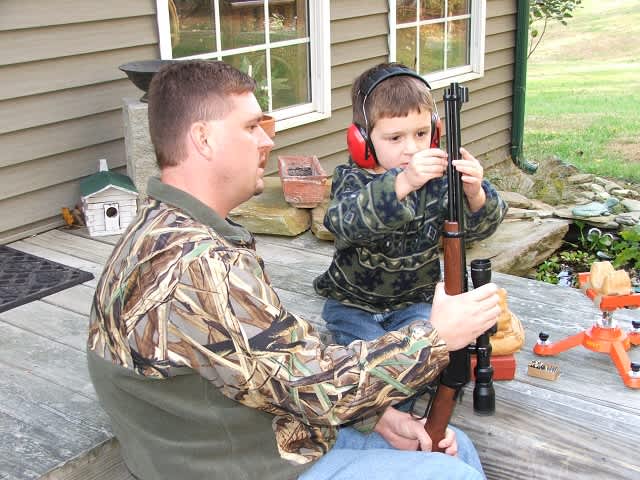Starting with the Right Gun
Lewis Creek Shooting School 06.25.12

Do you remember the first gun you ever fired? I remember my dad’s .22. I still have it, but it seems that it was a different gun then. At that time, it was very long and very heavy. I still remember that it felt very dense and heavy, the way a heavy target rifle feels to an adult who has never handled one.
I remember firing a shotgun for the first time, too. It was a 16 gauge single shot that weighed about 5 pounds. I thought the recoil was brutal. I was concerned with recoil and as a result, the first shotgun I bought was a seven pound 20 gauge gas operated semi-auto.
In those days there weren’t very many guns designed for small people. The first ones I recall were H&R Topper single shots in 20 and .410 gauges with short stocks and short barrels. It was probably 1980 before the major manufacturers started making pumps and semi-autos for small people. I keep saying small people because most women need shortened guns as much as young people.
Now we have youth .22s, youth shotguns and youth deer rifles. Some of these guns cost over a thousand dollars. We have come a long way from the $29.97 .410 full choke single shot. These new guns don’t just cost more; they provide a young shooter with a gun that will allow them to really learn how to shoot without handicaps.
Shotguns probably are the biggest chunk of this market. While that single shot .410 was OK for squirrels and the occasional rabbit, it was hardly a tool for learning the principals of wing-shooting. A .410 is the gauge for advanced shot-gunners, not novices. The ballistics of the .410 are unforgiving when firing at moving targets. Since the weight of the gun and the recoil of a 12 are too much for smaller people, the 20 gauge is the logical choice. The 20 gives a trade off of the size of the shot charge against its lighter weight. The 20 gauge can be pretty versatile, with a lot of loads available that allow it to do most of what shotguns are required to do.

For practical purposes the only guns worth serious consideration are pumps and semi-autos, since the single shots are too light to soak up the recoil and quality ones are close in price to the pumps. Young shooters also need the option of matching the choke to the application, an option only afforded with the pumps and autos with screw in chokes. If you take money out of the equation, the semi autos are the easy winner. Their weight is close to the pumps, but they have the added advantage of gas operation in most models. Gas operation spreads recoil out over a longer time period and makes the gun much more comfortable for the shooter.
If money is a major issue, the pumps look best. Youth model pumps in the three major brands often sell for less than $250.00. This is around half the price of the semi autos. If you do choose a pump, consider replacing the recoil pad. The ones that come on the guns are pretty hard and not nearly a effective as a Pachmayer or other name brand pad. The pumps do have the advantage of slightly lighter weight and being able to function on super light “trainer” shells.
Light weight is a big issue. For a small person to handle a gun and shoot moving targets, it must be light enough for them to move comfortably. Keep the ratio of gun weight to shooter weight in mind. A 6 pound gun in the hands of someone that weighs 90 pounds feels like a 12 pound gun in the hands of someone that weighs 180 pounds. Extra weight in the butt on the gun does not have so much effect, but on the muzzle, it makes swinging the gun very difficult.
In the rifle category the choices are simpler. Most of the youth guns are simple shortened versions of their adult counterparts. They are offered in low recoil calibers. I think the single shots, like the Thompson Center guns, are a valid choice for youth rifles. The extra recoil is not as much of a factor, since there is not as much repetitive shooting as with shotgun, so the light weight is not a liability.
Rifle or shotgun, regardless of type, make sure the gun is comfortable to shoot. The pain of excessive recoil can create bad habits that take years to reverse, or even worse, can turn a kid against shooting altogether.
While the concept of youth guns is fairly new, the need has always been there. We are fortunate to have so many to choose from. I have a 10 year old friend who shoots sporting clays. He is the son of my business partner, Billy Lagle. Trey shoots a 391 Berreta and does very well on doves, ducks and other game. He breaks around 35% on sporting clays and is deadly on simpler shots. Having the right gun makes all the difference.

